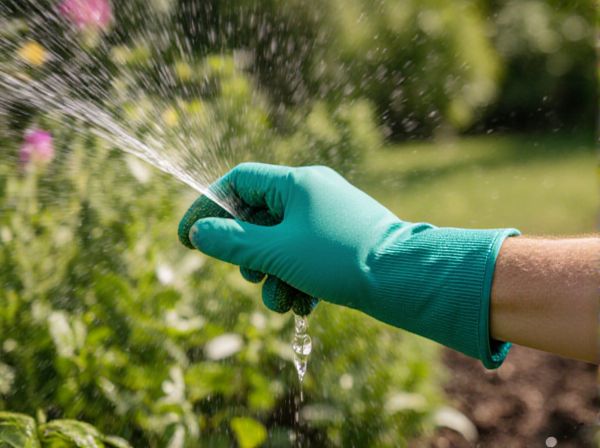
Overwatering vs Underwatering Illustration
Overwatering plants can lead to root rot and nutrient deficiency, while underwatering causes dehydration and wilting. Proper watering balances soil moisture, ensuring roots receive enough oxygen and nutrients for healthy growth. Monitoring soil dampness and adjusting watering frequency prevents stress and promotes vibrant plant development.
Table of Comparison
| Aspect | Overwatering | Underwatering |
|---|---|---|
| Definition | Excessive water supply causing waterlogged soil | Insufficient water supply leading to dry soil |
| Soil Condition | Constantly soggy or saturated | Dry, cracked, and hard |
| Root Health | Root rot and oxygen deprivation | Root dehydration and shrinkage |
| Plant Symptoms | Yellowing leaves, wilting despite moist soil | Wilting, dry leaves, and brown leaf edges |
| Growth Impact | Stunted growth, poor nutrient uptake | Delayed growth, nutrient deficiencies |
| Risk | Fungal infections and root diseases | Wilting and plant death from dehydration |
| Prevention | Water only when soil feels dry to touch | Water when top 1-2 inches of soil are dry |
Understanding Overwatering and Underwatering
Overwatering causes root rot and deprives plants of oxygen, leading to yellowing leaves and stunted growth, while underwatering results in wilting and dry, brittle foliage due to insufficient moisture for nutrient uptake. Recognizing symptoms such as soggy soil or persistent dryness aids in correcting watering practices to maintain optimal plant health. Proper monitoring of soil moisture levels ensures the prevention of overwatering and underwatering, promoting robust root systems and vigorous growth.
Key Signs of Overwatered Plants
Overwatered plants exhibit key signs such as yellowing leaves, wilting despite wet soil, and root rot indicated by a foul odor and mushy roots. Leaves may become soft and swollen, with brown or black spots appearing on the foliage due to fungal infections caused by excess moisture. Soil that remains consistently soggy or waterlogged prevents oxygen absorption, leading to stunted growth and eventual plant decline.
Symptoms of Underwatered Plants
Underwatered plants exhibit symptoms such as wilting leaves, dry and brittle foliage, and slow growth due to insufficient moisture absorption. Soil often appears dry and pulls away from the edges of the pot, indicating inadequate hydration. Leaves may also develop brown, crispy edges as a result of prolonged water scarcity.
Causes of Overwatering in Gardens
Excessive watering in gardens often results from poor soil drainage, heavy clay soils, or frequent irrigation schedules without considering weather conditions. Symptoms such as yellowing leaves and root rot indicate waterlogged roots deprived of oxygen. Overwatering disrupts nutrient uptake, promoting fungal diseases and stunted plant growth.
Common Reasons for Underwatering
Common reasons for underwatering include irregular watering schedules, insufficient water volume, and poor soil moisture retention. Neglecting to monitor soil dryness or relying solely on surface moisture can cause plants to receive inadequate hydration. Environmental factors such as high temperatures and low humidity also contribute to faster water loss, increasing the risk of underwatering.
Impact of Overwatering on Plant Health
Excessive watering reduces oxygen availability in the soil, leading to root rot and fungal infections that severely compromise plant health. Overwatered plants exhibit yellowing leaves, wilting despite moist soil, and stunted growth due to impaired nutrient uptake. Maintaining proper watering schedules based on plant species and soil type is crucial to prevent these detrimental effects and ensure healthy root systems.
How Underwatering Affects Plant Growth
Underwatering limits a plant's ability to absorb essential nutrients, causing stunted growth and wilting leaves. Insufficient water disrupts photosynthesis and cellular functions, leading to dry, brittle foliage and reduced overall vigor. Prolonged drought stress weakens a plant's immune system, increasing susceptibility to pests and diseases.
Tips to Prevent Overwatering
Monitor soil moisture using a moisture meter to avoid overwatering your plants, ensuring the top inch of soil dries out before watering again. Use pots with drainage holes to allow excess water to escape, preventing root rot caused by waterlogged soil. Implement a consistent watering schedule tailored to your plant species, adjusting frequency based on seasonal changes and ambient humidity levels.
Strategies to Avoid Underwatering
Consistent soil moisture monitoring is essential to avoid underwatering and ensure plants receive adequate hydration. Implementing drip irrigation systems provides a controlled water supply directly to the root zone, minimizing water stress. Mulching around plants helps retain soil moisture, reducing evaporation and maintaining optimal hydration levels.
Finding the Right Watering Balance
Finding the right watering balance involves recognizing plant-specific moisture needs to avoid the risks of both overwatering and underwatering. Overwatering can lead to root rot and fungal diseases, while underwatering causes dehydration and stunted growth. Monitoring soil moisture levels and adjusting watering frequency based on environmental factors ensures optimal plant health and growth.
Overwatering vs Underwatering Infographic

 gardendif.com
gardendif.com